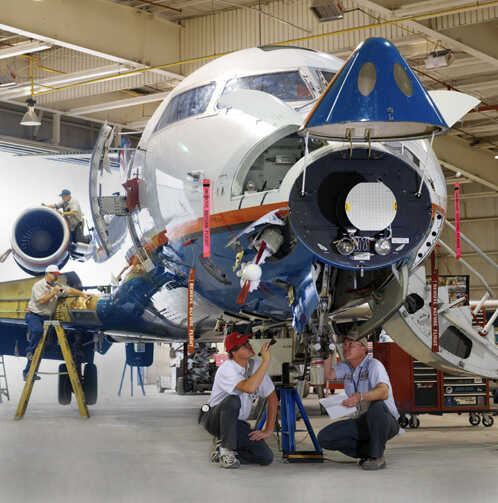Factors that Could Alleviate the Aviation Mechanic Shortage

There is a dire need for aviation mechanics and the situation could only worsen with Boeing projecting that the global commercial aviation industry will need to recruit, train, and hire some 610,00 new maintenance technicians over the next 20 years.
“A severe shortage of skilled workers, including mechanics and technicians, affects the entire aviation industry, and finding a quick fix anytime soon seems unlikely,” wrote Michael Wildes in Flying magazine in August 2022.
Aviation and Aerospace Sector Hit by Labor Shortages
The historically tight labor market has hit all industries, but the aviation and aerospace sector has been particularly challenged to hire skilled workers.
Raytheon Technologies CEO Greg Hayes on second-quarter earnings call, according to Flying magazine, said: “This does not get solved this year,” he said. “I think the only thing that’s going to solve labor availability, and I hate to say this, is a slowdown in the economy because right now, there simply aren’t enough people in the workforce for all of our suppliers.”
Boeing says that factors that could alleviate the aviation mechanic shortage include:
- Continued investment in an uninterrupted pipeline of qualified personnel to replace those who either reached retirement age or opted for voluntary early retirement during the pandemic.
- The return of personnel furloughed during the pandemic, which will provide only limited relief, as many have already left the industry.
- Increased training capacity of new mechanics and technicians utilizing new solutions adopted by schools, training providers, and regulators.
It will not, however, be an easy fix, with Boeing acknowledging there currently is an “insufficient training capacity to support a significant personnel shortage and the lag time involved in bringing personnel online while prioritizing safety.”
Boeing Pilot and Technician Outlook 2022-2041
Boeing’s 2022 Pilot and Technician Outlook (PTO) projects that 602,000 new pilots, 610,000 new maintenance technicians, and 899,000 new cabin crew members will be needed to fly and maintain the global commercial aviation fleet over the next 20 years.
“Competition to recruit and retain top-tier talent will be strong as more flights and routes are added,” says the PTO. “As air traffic increases and aircraft come out of storage, aviation technicians will play a vital role in inspecting, repairing, and restoring them to airworthiness. While technicians have been busy in aircraft and engine preservation over the past two years, the near term will require additional labor to bring airplanes back into service.”
The PTO estimates that over the next 20 years, 610,000 new technicians will be needed to meet demand from fleet operators and providers of maintenance, repair, and overhaul services.
“The combination of fleet growth, attrition, and replacement will continue to drive high demand for the foreseeable future,” says the PTO.
Technicians new personnel demand by region, according to the Boeing report:
- Africa: 21,000
- China: 124,000
- Europe: 120,000
- Latin America: 35,000
- Middle East: 50,000
- North America: 134,000
- Northeast Asia: 24,000
- Oceania: 10,000
- South Asia: 34,000
- Southeast Asia: 58,000
Training Innovation Could be Key in Adding Aviation Mechanics
The Boeing report highlights that innovation in training new aviation mechanics and other technicians could be crucial to shoring up the labor force.
“Personnel trained since the start of the pandemic have encountered new solutions adopted by schools, training providers, and regulators,” said the PTO. “Digital technologies, virtual formats, and other developments have helped bridge gaps in subject matter while improving the delivery and implementation of training.”
Some of the changes taking place:
- Methodologies are moving towards a Holistic-based approach that focuses on competencies and away from prescriptive, task-based syllabuses.
- New investments are being made in artificial intelligence, machine learning, and mixed reality that will train students more efficiently and effectively.
Retirements Spread Aviation Workforce Thin
The aviation workforce, especially mechanics, is spread thin with the tall task of learning new skills to handle the emerging technologies of the latest aircraft while maintaining a skillset to take care of legacy equipment.
“Technicians are critical to operational safety, and they play a key role in supporting the industry’s recovery. But in some cases, they’re spread thin,” said the PTO.
Retirements, and early retirements, took off during the pandemic.
“There was kind of a structural issue already before COVID,” Jonas Murby, principal at AeroDynamic told Flying magazine. “But when COVID hit, the oldest and most experienced people suddenly left aviation.”
Boeing expects the problem to not abate anytime soon and could accelerate.
“In mature aviation markets, the average age of the technician workforce keeps rising, while the number of new entrants to the profession tapers off,” said the PTO. “Educational outreach efforts will be necessary to reverse this trend, and knowledge transfer to junior workers will remain essential to conserve critical expertise and specialized skills.”
Challenges to Recruiting New Aviation Mechanics
The challenge for aviation mechanics is the marriage of new and old technology in today’s fleets.
“New sensors and flight data recorders generate torrents of data, enabling maintenance providers to implement new, predictive solutions. These innovations drive demand for technicians who can accurately analyze, interpret, and act on the information generated,” said the PTO. “At the same time, older aircraft remain in service, requiring providers to employ technicians with vast skillsets who can maintain and repair aircraft built decades ago.”
Murby told Flying magazine that other aspects make it hard to recruit and keep aviation mechanics.
“If you’re a mechanic, perhaps life outside aviation means less work on a hot ramp or in the rain. It’s also less work with dirt and at a higher salary,” said Murby.
Current labor shortages are putting even more stress on the available mechanics.
“The shortages themselves exacerbate that problem because a company with too few mechanics certainly doesn’t want those mechanics to work fewer hours,” said Murby.
Industry experts think that it will take more flexibility, upgraded technology, and higher salaries to lure mechanics to the aviation industry.



